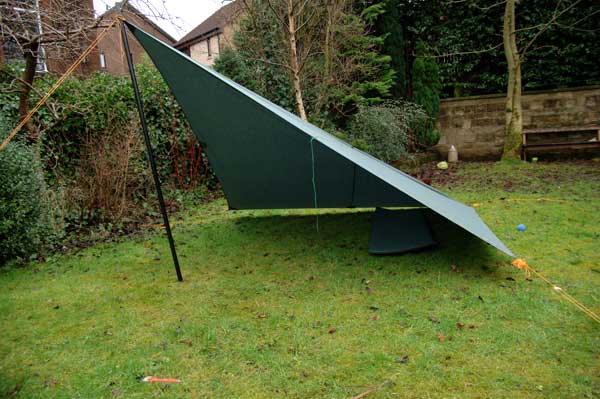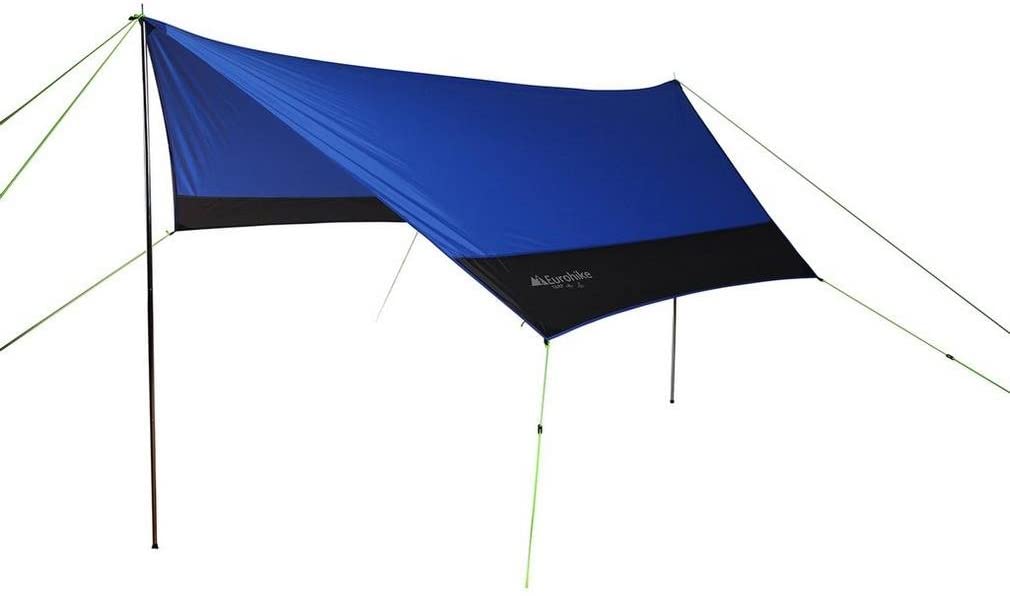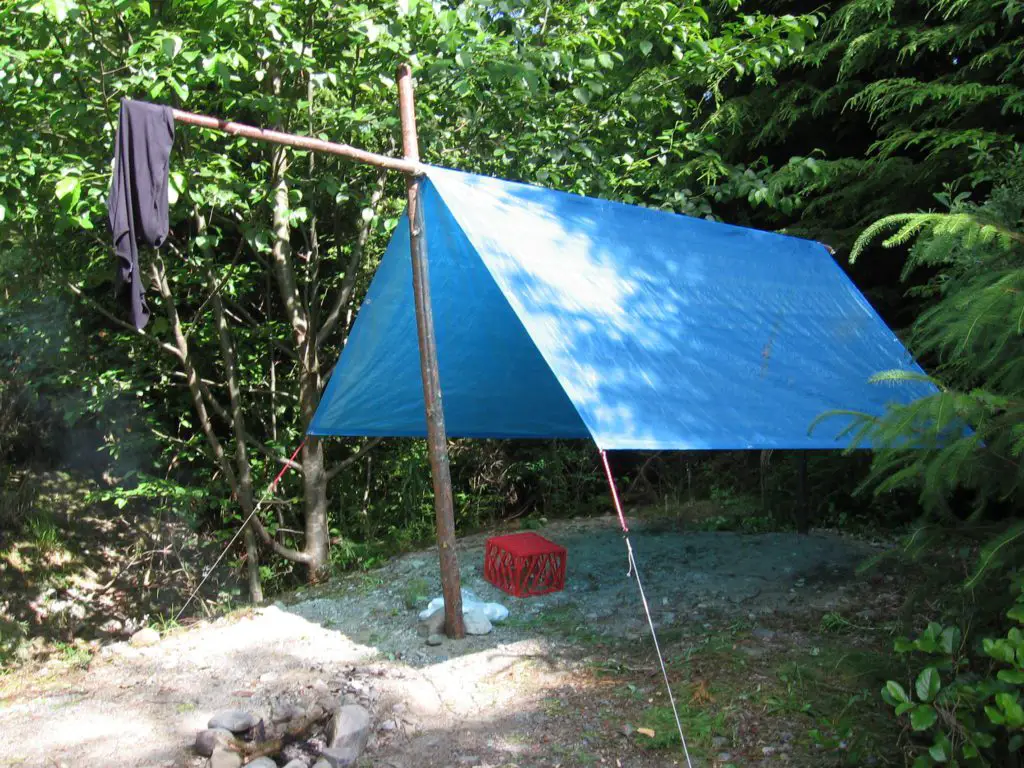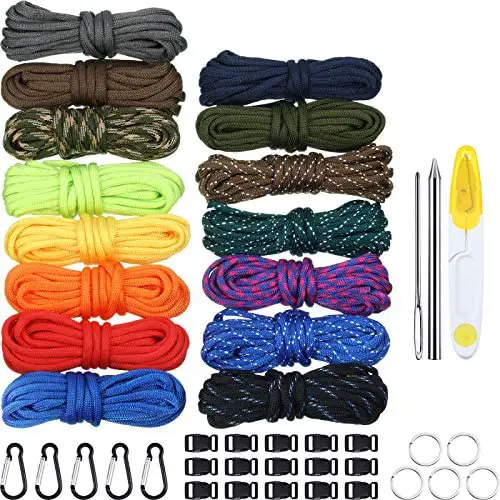We support our blogging by participating in affiliate programs. We may receive a small commission if you click through a link in this post and purchase something you need, however, this will have no impact on the price you pay for the item. Learn more about it on the Disclosure page.
Have you ever arrived at your camping pitch, planning to cover your tent with a tarp and found there are no trees to tie it up with? I have and it took me a long time to get the right answer from a hasty google search, but I did find the answer. Today I will share my tips on how to tarp over a tent with no trees.
If there are no trees to give you height for your tarp, the best options are to use either an adjustable pole or a solid branch (if you can find one). You will need at least one pole or branch for the higher end of the tarp as well as guy lines or paracord to hold that end of the tent up.
Read on to find out more about how to get the ideal setup to keep your tent sheltered from the wind.
Recommended Gear
Unigear Hammock Rain Fly Tent Tarp 300cm x 300/400/500cm
The Unigear Tent Tarp is made from a durable, water-resistant material designed to protect your tent from heavy rain and wind.
Check Price:
Adjustable Universal Telescopic Tent Poles
These poles are a great option for putting your tarp up if you don’t have a tree to tie it to. With a height between 180cm and 220cm, this should give you plenty of height to cover most tents.
Check price:
Reflective Cord Guy Line 13 Feet/ 4M Long
These guylines are great for helping you create some resistance in order to keep the poles upright and the tarp pulled tight.
Check Price:
Bungee Cord Balls
These bungee cords are great for securing down your tarp as well as providing a little bit of flex to avoid potential damage to your tarp.
Check Price:
Why should I use a tarp over a tent?
Using a tarp over a tent is a great way to shelter you and your camping area from the elements. It is especially useful when you are camping in a bivvy bag.
Shelter from the rain

Positioning a tarp over your tent is a great way to add extra protection to your tent when if the weather turns.
If you are unsure if you’re tent’s waterproofing is up to scratch and you haven’t got time to waterproof your tent, putting a tarp up over your tent will ensure that you don’t have to find out the hard way!
Instead of the rain landing on your tent, the polythene layer you put up over the top will get wet.
Just think about that for a minute. Not only will you not have to worry about your tent leaking, but you will also have a dry tent to put away in the morning if it does rain. I think that is a win-win situation.
Shelter from the wind

Similar to the above, using a tarp to protect against the wind is a great way to protect your tent. This is particularly useful if you are unsure as to how sturdy your tent is.
The one downside here is that, depending on the material you buy, the wind blowing your tarp can be a little noisy. To avoid this, make sure you pull the tarp as taut as you can to reduce the impact.
Also, don’t put it completely flat to the wind as this will likely result in the tarp being pulled out of the ground. Instead, try to position the tarp in such a way as to allow the wind to blow across and over your tent.
How do I hang the tarp over my tent without trees
The easiest way to set up your tarp when there are no trees around is to use an adjustable pole. The amount you use will depend on how many poles you would like to take with you when camping.
One pole tarp shelter – Closed-End A-Frame

If you only have one pole you will need to create a shelter with your tarp. The closed-end a-frame will design is what you need.
In the picture above you can see that this has been set up flat to the ground, as this is set up for ground sleeping. To raise this above your tent, you would simply use guy lines pulled tight from each of the corners you are staking down. This will allow you to raise the level of the pole being used for tension.
One pole tarp over tent setup guide
- Tie guy lines or paracord to each of the corners of your tarp.
- Stake the rear guy line in position (don’t tighten this up yet)
- Stake the two side guy lines into the ground (again don’t tighten these yet)
- Insert your adjustable pole into the tarp and put this into position
- Attached a guy line to the pole and pull this to full tension at the opposite angle to the rear guy line
- Stake this guyline into the ground in the desired location
- Adjust the tension of the other guy lines to make a strong and secure shelter
Two pole tarp shelter – A-Frame

If you have two poles available for setting up your tarp over your tent, then the A-Frame shelter will be perfect for you.
You will see that this setup is very similar to a traditional tent set-up, only this time it is raised off the ground. To achieve this height, it is once again a matter of ensuring you have your guy line pulled tight and your poles adjusted to the right height.
Two pole tarp over tent setup guide
- Tie guy lines or paracord to each of the corners of your tarp.
- On one side of the tarp (not an end where the poles will go), stake your guy lines into the ground.
- Insert one of your adjustable poles into the tarp and secure it in place with a guy line
- Do the same as step 3 at the other end of the tarp
- On the other side of your tarp, pull the guy lines tight and stake them into the ground
- Go around the tarp and adjust the guy lines as necessary to ensure the tarp is taut and secure
What if I don’t have a pole?

If you don’t have a pole with you when setting up your tent there are a few options you can explore. None of these will be ideal, but could still provide some good shelter for you:
- Use a stick or branch in place of your pole. This will need to be long and strong to replace your pole
- Position your sleeping arrangement near a hill and use this to get the height you need from one end
- Use a pile of rocks for height. You will need a lot of rocks to do this effectively. A dry stone wall would be good for this, but this might not provide you with enough height over a tent
How to Stop Your Tarp Falling Down
Now you know how to put a tarp up over your tent, the next thing is to make sure it doesn’t fall down! Here are a few tips to help avoid this happening to you.
Use the right cord
Using the right type of cord is key to making sure you get the tarp secure.
You need to use a cord or rope that is strong and doesn’t have too much give. An elasticated cord can be used as long as it is not too stretchy.
The ideal cords to use are:
- Paracord – Strong and secure rope with multiple uses. Ideal for securing the tarp
- Guy lines – These are the ropes used for tents. Thinner than paracord, but still very strong
- Strong Bungee Cord – This will need to be pulled as tight as possible so as to not flex too much. Too flexible and the tarp won’t be tight enough
Use the right knot

Making sure you have a tight knot is also important for securing your tarp.
The Bowline knot is a great choice here as it is strong and secure. Make sure you secure this knot around the eyelets of the tarp and use tent pegs or stakes in the loop at the ground level.
Don’t leave a flat spot on the tarp
Make sure you set your tarp up at an angle over your tent.
If you have the tarp flat on the top, water will collect on top of the tarp and weigh it down. It won’t take long for your tarp to weigh enough to pull the stakes out of the ground and come out completely. That’s a quick way to get wet under your tarp!
How Do I Choose A Tarp For Camping
Considerations When Choosing a Tarp
Size and Coverage
- The size of the tarp dictates the area it can cover.
- Consider the number of campers, gear, and activities you plan to undertake under the tarp.
- A larger tarp provides more coverage, but it might also add weight to your pack.
Material Durability
- Tarps come in various materials, including nylon, polyester, and canvas.
- Nylon is lightweight and dries quickly.
- Canvas is more durable but heavier.
- Choose a material that suits your camping style and the conditions you’ll likely encounter.
Weight and Portability
- For backpackers, weight is a crucial factor.
- Look for lightweight materials without compromising on durability.
- Some tarps are even made from ultralight silnylon, perfect for minimalist adventurers.
Attachment Points and Setup
- Easy setup is key in the wilderness.
- Ensure your chosen tarp has reinforced grommets or loops for secure attachment.
- Some tarps also include guylines and stakes, making your setup hassle-free.
Matching the Tarp to Your Camping Style
Your camping style and the environments you frequent play a role in your tarp selection. If you’re a solo backpacker, a lightweight rainfly tarp might be your best bet. Families might lean towards larger shelter tarps to accommodate everyone comfortably.
Tips for Caring and Maintaining Your Tarp
Proper care extends the lifespan of your tarp. Shake off debris before packing, and avoid prolonged exposure to UV rays. When storing, make sure it’s clean and completely dry to prevent mold and mildew.
FAQs
Should You Put a Tarp Over Your Tent?
No one enjoys waking up to a wet tent, but is putting a tarp over your tent really the answer?
There are pros and cons to both sides of the argument. On one hand, a tarp can keep your tent dry in light rain or mist. It can also add an extra layer of insulation on cold nights. However, tarps can be heavy and awkward to carry, and they can also damage your tent if not used properly.
Ultimately, the decision whether or not to put a tarp over your tent depends on the weather conditions and your personal preferences. If you’re camping in wet or cold weather, a tarp may be a good idea. But if you’re camping in dry weather, there’s no real need to carry one around.
Can You Use a Tarp as A Rainfly?
The verdict is yes, you can use a tarp as a rainfly. Tarps make great ultralight rainflies because they’re typically waterproof and large enough to cover a variety of shelter set-ups. They can also be rigged in different ways to create an even more weatherproof seal. While they may not be as durable as traditional rainflies, they’re a good option for short-term or minimalist trips.
Is a Rainfly Necessary?
The answer to this question is a resounding, “It depends.” If you are camping in an area that has frequent rain showers, then a rainfly is definitely necessary. However, if you are camping in an area that is known for its dry weather, then you may be able to get away without using one.
A rainfly serves two main purposes: it protects your tent from getting wet and it keeps the inside of your tent cooler. If you are camping in an area with high humidity levels, then a rainfly is essential for keeping your tent dry. In such a case, the fly should extend all the way to the ground to prevent moisture from seeping into the bottom of your tent.
If you are camping in an area with low humidity levels, however, a rainfly may not be necessary.
Summary
So how do you tarp over a tent with no trees to secure your tarp? The easiest way is to use adjustable poles to give you the height you need. There are alternative methods, such as using rocks, however, these are a little trickier to set up and not as secure as using poles.
FAQs
Should you put a tarp over your tent?
No one enjoys waking up to a wet tent, but is putting a tarp over your tent really the answer?
There are pros and cons to both sides of the argument. On one hand, a tarp can keep your tent dry in light rain or mist. It can also add an extra layer of insulation on cold nights. However, tarps can be heavy and awkward to carry, and they can also damage your tent if not used properly.
Ultimately, the decision whether or not to put a tarp over your tent depends on the weather conditions and your personal preferences. If you’re camping in wet or cold weather, a tarp may be a good idea. But if you’re camping in dry weather, there’s no real need to carry one around.
Can you use a tarp as a rainfly?
The verdict is yes, you can use a tarp as a rainfly. Tarps make great ultralight rainflies because they’re typically waterproof and large enough to cover a variety of shelter set-ups. They can also be rigged in different ways to create an even more weatherproof seal. While they may not be as durable as traditional rainflies, they’re a good option for short-term or minimalist trips
Is a rainfly necessary?
The answer to this question is a resounding, “It depends.” If you are camping in an area that has frequent rain showers, then a rainfly is definitely necessary. However, if you are camping in an area that is known for its dry weather, then you may be able to get away without using one.
A rainfly serves two main purposes: it protects your tent from getting wet and it keeps the inside of your tent cooler. If you are camping in an area with high humidity levels, then a rainfly is essential for keeping your tent dry. In such a case, the fly should extend all the way to the ground to prevent moisture from seeping into the bottom of your tent.
If you are camping in an area with low humidity levels, however, a rainfly may not be necessary.
Can I machine wash my camping tarp?
It’s generally better to hand wash your tarp using mild soap and cold water. Machine washing might damage the material and grommets.
Do all tarps come with guylines and stakes?
Not all tarps include guylines and stakes. Some brands offer them separately, so make sure to check before purchasing.







